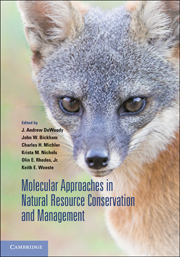Book contents
- Frontmatter
- Contents
- Contributors
- Preface
- 1 Biodiversity discovery and its importance to conservation
- 2 Gene flow, biodiversity, and genetically modified crops: Weedy rice in Thailand
- 3 A community and ecosystem genetics approach to conservation biology and management
- 4 Vertebrate sex-determining genes and their potential utility in conservation, with particular emphasis on fishes
- 5 Historical and contemporary dynamics of adaptive differentiation in European oaks
- 6 Association genetics, population genomics, and conservation: Revealing the genes underlying adaptation in natural populations of plants and animals
- 7 Hybridization in threatened and endangered animal taxa: Implications for conservation and management of biodiversity
- 8 Pollen and seed movement in disturbed tropical landscapes
- 9 Implications of landscape alteration for the conservation of genetic diversity of endangered species
- 10 Integrating evolutionary considerations into recovery planning for Pacific salmon
- 11 Using molecular methods to improve the genetic management of captive breeding programs for threatened species
- 12 Wildlife reintroductions: The conceptual development and application of theory
- 13 Evolutionary toxicology
- Index
- Plates
- References
6 - Association genetics, population genomics, and conservation: Revealing the genes underlying adaptation in natural populations of plants and animals
Published online by Cambridge University Press: 05 July 2014
- Frontmatter
- Contents
- Contributors
- Preface
- 1 Biodiversity discovery and its importance to conservation
- 2 Gene flow, biodiversity, and genetically modified crops: Weedy rice in Thailand
- 3 A community and ecosystem genetics approach to conservation biology and management
- 4 Vertebrate sex-determining genes and their potential utility in conservation, with particular emphasis on fishes
- 5 Historical and contemporary dynamics of adaptive differentiation in European oaks
- 6 Association genetics, population genomics, and conservation: Revealing the genes underlying adaptation in natural populations of plants and animals
- 7 Hybridization in threatened and endangered animal taxa: Implications for conservation and management of biodiversity
- 8 Pollen and seed movement in disturbed tropical landscapes
- 9 Implications of landscape alteration for the conservation of genetic diversity of endangered species
- 10 Integrating evolutionary considerations into recovery planning for Pacific salmon
- 11 Using molecular methods to improve the genetic management of captive breeding programs for threatened species
- 12 Wildlife reintroductions: The conceptual development and application of theory
- 13 Evolutionary toxicology
- Index
- Plates
- References
Summary
INTRODUCTION
Understanding the genetic basis of complex adaptive traits is key to understanding how natural and anthropomorphic factors have influenced and will influence the shape of genetic diversity and trajectory of evolution in natural populations. Complex adaptive traits are quantitative traits – those that vary on a continuous scale, and even more generally, are sometimes defined as traits that are expressed as a function of products from multiple genes (Falconer & MacKay 1996; Roff 1997; Lynch & Walsh 1998). Although classical quantitative genetics has revealed the genetic basis to numerous morphological, physiological, and life history traits in plants and animals, the actual genes (loci) and allelic variation with loci underlying key functional differences among organisms remain unknown. Understanding the genes involved in species- and population-level diversity can provide important tools (i.e., genetic markers) for resource managers that are charged with conservation, management, and restoration of natural populations. In this chapter, our examples and review are focused on non-model, non-domesticated organisms as it is the diversity in natural populations, shaped by the natural processes of evolution, with which natural resource managers are most concerned.
Population genetics has undoubtedly been one of the most important fields in the conservation, management, and restoration of native plant and animal species. Together with ecological and life history information, “neutral” genetic markers, or those mirroring the neutral demographic processes of natural populations, are important tools for the delineation of management units or evolutionary significant units for conservation and management. Loci that have been shaped by natural selection, in the process of adaptive population divergence, can however exhibit levels of differentiation markedly different than neutral loci (Leinonen et al. 2008; Vali et al. 2008; Nosil et al. 2009).
- Type
- Chapter
- Information
- Publisher: Cambridge University PressPrint publication year: 2010
References
- 9
- Cited by



